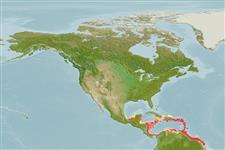Common names from other countries
>
Ophidiiformes (Cusk eels) >
Ophidiidae (Cusk-eels) > Ophidiinae
Etymology: Lepophidium: Latin, lepus, leporis = rabbit + Greek, ophis = serpent (Ref. 45335).
More on author: Robins.
Environment: milieu / climate zone / depth range / distribution range
Ecologie
marien demersaal; diepte 27 - 165 m (Ref. 91765). Tropical; 21°N - 2°N, 97°W - 49°W (Ref. 91765)
Western Atlantic: along the northern coast of South America from Colombia to Cabo Orange, Brazil (north of the mouth of the Amazon); including Gulf of Campeche, Mexico, Nicaragua, Panama, shelf area from northern Puerto Rico to the US Virgin Islands.
Grootte / Gewicht / Leeftijd
Maturity: Lm ? range ? - ? cm
Max length : 27.0 cm SL mannelijk / geslacht onbekend; (Ref. 91765); common length : 18.0 cm TL mannelijk / geslacht onbekend; (Ref. 5217)
Korte beschrijving
Determinatiesleutels | Morfologie | Morfometrie
Dorsale stekels (totaal) : 0; Dorsale zachte stralen (totaal) : 127 - 130; Anale stekels: 0; Anale zachte stralen: 104 - 112; Wervels: 69 - 72. This species is characterized by the following: usual number of vertebrae, precaudal 15 (14), caudal 56-57 (54-58), total 71-72 (69-72); fin rays, dorsal 127-130 (125-133), anal 106-108 (104-112) pectoral 20-21 (22); pyloric caeca usually 3 (1-4), most often with 2 in one tier and 1 in second, when 4, they are 3+1; first gill arch with rudimentary rakers 2 on the upper arm, 4 (rarely 5) developed rakers on the lower limb, usually 2 (1-3) rudimentary rakers anteriorly on the first arch; total rakers usually 8-9; dorsal-fin origin between neural spines 2-3 (18 specimens) or 3-4 (11 specimens), in most instances is almost directly over neural spine 3 (Ref. 91765).
Common species (Ref. 34024). Found on the continental shelf, on soft bottom (Ref. 5217). Oviparous, with oval pelagic eggs floating in a gelatinous mass (Ref. 205).
Levenscyclus en paargedrag
Maturities | Voortplanting | Spawnings | Egg(s) | Fecundities | Larven
Robins, C.R., R.H. Robins and M.E. Brown, 2012. A revision of Lepophidium (Teleoastei, Ophidiidae), with descriptions of eight new species. Bulletin of the Florida Museum of Natural History 52(1):1-94. (Ref. 91765)
Status op de Rode Lijst van het IUCN (Ref. 130435)
CITES (Ref. 128078)
Not Evaluated
Gevaar voor de mens
Harmless
Gebruik door de mens
Tools
Speciale rapporten
Download XML
Internetbronnen
Estimates based on models
Preferred temperature (Ref.
115969): 21.7 - 27.1, mean 25.6 (based on 64 cells).
Fylogenetische diversiteitsindex (Ref.
82804): PD
50 = 0.5000 [Uniqueness, from 0.5 = low to 2.0 = high].
Bayesian length-weight: a=0.00234 (0.00101 - 0.00543), b=3.16 (2.98 - 3.34), in cm Total Length, based on LWR estimates for this Genus-body shape (Ref.
93245).
Trofisch niveau (Ref.
69278): 3.6 ±0.7 se; based on size and trophs of closest relatives
Weerstandsvermogen (Ref.
120179): Hoog, minimale populatieverdubbelingstijd minder dan 15 maanden (Preliminary K or Fecundity.).
Fishing Vulnerability (Ref.
59153): Low vulnerability (23 of 100).
